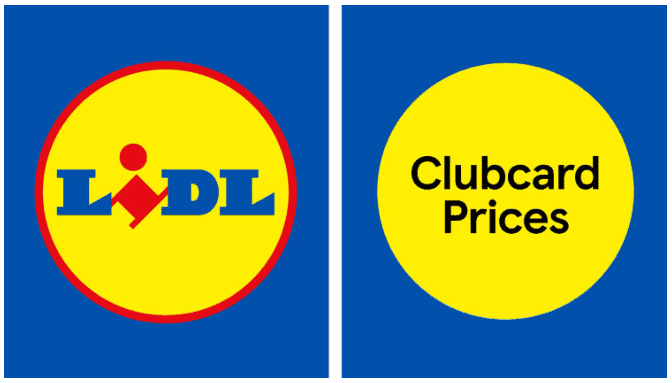

As a matter of UK trade mark law, if you asked most trade mark attorneys or lawyers whether Tesco’s Clubcard Prices sign was an infringement of Lidl’s trade mark (both shown above), in my view most would say: “no, it isn’t, because the only similarity lies in the background, blue square and yellow circle (itself not the same because the Tesco device omits the red outer circle) and the really distinctive and dominant part of the Lidl mark, being the stylised word Lidl, hasn’t been taken”. And yet, in the High Court today, Joanna Smith J has found against Tesco and decided that not only does it constitute UK trade mark infringement but also passing off and copyright infringement.
So how did she get there? The judgement is a long one – 102 pages. This short note cannot possibly do justice to the detail but is intended only as a short summary for those interested in a quick understanding of the main points decided.
Trade Mark Infringement – Lidl had to prove a number of things (highlighted below in bold)
Confusing similarity of the marks was not pleaded. Rather it was alleged that Tesco was “free riding” off, and/or diluting, the reputation of the Lidl mark (i.e. s. 10(3) infringement only). And that is what the judge found.
Of course, it was acknowledged by Tesco that the mark had the requisite reputation (massively used by Lidl) and the judge found that despite the obvious differences between them, and the predominance of the Lidl mark on the one hand and Clubcard mark on the other, they were sufficiently similar to each other for the case to get off the ground.
She then needed to find that the average consumer would make a link between the two and she did so based on one of Tesco’s internal pre-launch surveys, which showed that in relation to a certain out-of-home (Billboard) advertisement, 8% of the 276 customers who saw it thought it was for Lidl, and also on the basis that of all the people who had complained to either Tesco or Lidl, some made a connection between the registered mark and the Tesco sign (so called ‘vox populi’). There was more. Another of Tesco’s pre-launch surveys asked people to assess 4 very different options, asking various questions – the judge decided that the results showed that a link was being made, though the survey had very few participants and only between 4 and 6% of the third or so who spotted any change (so 1.5% of the 400 consumers shown the sign) mentioned either Aldi or Lidl. In fact, only 1% of the 400 consumers shown the sign mentioned Lidl as opposed to Aldi. Lidl also brought in a couple of witnesses who had written to Lidl to complain about Tesco’s sign who thought there was a link and that Tesco were copying Lidl. And finally, in the prelaunch period, a couple of people internally within Tesco had spotted a similarity. The fact that there was considerable brand misattribution within the supermarket marketplace (Lidl’s own internal documents, provided to the Court, showed that misattribution levels of 30% or more are commonplace in the supermarket sector), which the judge acknowledged, didn’t alter her findings.
Lidl went on to allege that Tesco intended to cause detriment to the distinctive character of the Lidl mark or take unfair advantage of it. There was no evidence of that. On the contrary, Tesco were, unsurprisingly, trying to promote their Clubcard – arguably the retail industry’s most valuable brand asset (apart from the supermarket names themselves) – independently from Lidl. The judge agreed. There was no intention to “freeride” but that was, she held, the effect of what had happened.
In terms of “detriment” to Lidl as a result of the Tesco use, Lidl sought to persuade the court that it had to launch a counter advertising campaign called “Unmatched Value” to deal with it. Though the campaign was in fact launched against all supermarkets, the judge found that to be sufficient because the Tesco Clubcard Prices scheme was one of the targets of the campaign. Tesco were, in addition, taking unfair advantage of the Lidl logo “due to the resemblance between [them]” even though there was no subjective intention by Tesco to achieve that end.
Could Tesco’s acts be defensible because they were with “due cause“? Tesco alleged that they were using their house blue colour and a yellow circle to denote value (which a number of other supermarkets also did), but the judge found that that was not enough – it was the combination of blue square and yellow circle that was unique to Lidl in the supermarket sector so there was no ‘due cause’ relating to Tesco’s use.
But what about the Wordless Mark (i.e. the Lidl logo shown above, but without the word “Lidl”) that Lidl had also asserted against Tesco? The judge found that, if that was a valid registration, it too was infringed. That, of course, is unsurprising given the finding in relation to the full logo. It was a mark that had never in fact been used on its own by Lidl. Lidl argued that they were using it every time they used the mark shown above (“Mark with Text”). Lidl deployed a survey which showed that a substantial number of people (73%) recognised the Wordless Mark by mentioning Lidl when asked the question: “what do you think this image is?”. Tesco argued that this did not prove origin association i.e. that the Wordless Mark is perceived as designating the origin of Lidl’s goods or services exclusively. The judge disagreed. Could the mark be revoked for non-use? No said the judge – using the Mark with Text also constituted using the background sufficient to avoid revocation of the Wordless Mark for non-use, rejecting Tesco’s submission that the Wordless Mark was a banal, trite or commonly used background, being instead a unique combination only used by Lidl in the supermarket sector.
Tesco also argued that the various registrations of the Wordless Mark should be invalidated because they were applied for in bad faith. Tesco argued that there was no bona fide intention to use the Wordless Mark at the times the various registrations were filed, and that the initial filing was made solely for the purpose of deployment as a weapon in legal proceedings, not in accordance with the function of being used on goods to denote origin. Subsequent filings for similar marks were attempts to “evergreen” the original filing done by Lidl to avail themselves of a fresh grace period during which Lidl would not be required to show use. The Court of Appeal, earlier on in this action, and overturning this same judge on the point, held that the onus was on Lidl to disprove bad faith, Tesco having done enough in its allegations to switch the onus of proof. Lidl had, in response, put in a statement of case on good faith, giving a number of reasons as to why the judge might find that Lidl had been acting in good faith but the judge rejected them all. Lidl had indeed filed its registrations for the Wordless Mark in bad faith, and these should be invalidated.
Passing off
Lidl alleged that Tesco also were passing off their goods as being price matched against Lidl by use of their sign. The judge found that the fact that there was a link being made by consumers between the Lidl registration and the Tesco device was sufficient for her to find that there was passing off of the kind alleged.
Copyright infringement
Finally, Lidl alleged that it owned copyright in its logo and that Tesco had copied it. The Lidl logo itself had been designed in various stages over a 30 year period. The work alleged to be copied was the final version which differed from the previous version only by the inclusion of a blue background. The judge found that ‘by its combination of text colours and shapes’, the logo was protected by copyright and that there was a statutory presumption that Lidl owned it (s 104 CDPA). Had Tesco copied? The judge found that Tesco itself had not copied but that an external design agency, engaged on a different project months before work began on the CCP device, had produced a design (amongst a series of a hundred or so other designs) which the judge considered to be sufficiently similar to constitute copyright infringement and that by adopting it, Tesco had themselves infringed.
Conclusion
The decision does not affect whether Tesco will continue to sell at Clubcard Prices, which, of course, it will continue to do. Tesco is going to seek leave to appeal.
